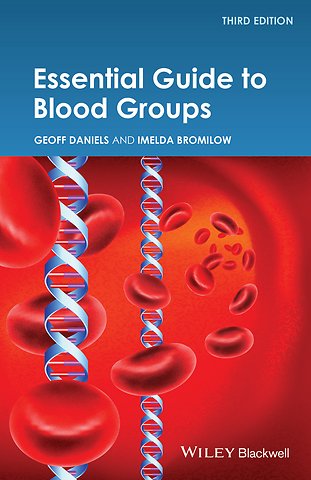Essential Guide to Blood Groups
Samenvatting
A short, up–to–date text on blood groups, for people working or training in the field of blood transfusion, transplantation, or human genetics, but who are not specialising in the field of blood groups, the third edition of Essential Guide to Blood Groups is a pocket–sized book, containing full colour text together with schematic figures and tables. The book comprises an introduction to blood groups, followed by chapters on techniques, information on various blood groups, antibodies, quality assurance in immunohaematology, and it concludes with chapters on troubleshooting in the laboratory, and FAQs. It also covers the serology, inheritance, biochemistry and molecular genetics of the most important blood group systems.
Specificaties
Inhoudsopgave
1 An introduction to blood groups 1
What is a blood group? 1
Blood group antibodies 3
Clinical importance of blood groups 3
Biological importance of blood groups 3
Blood group systems 4
Blood group terminology and classification 4
2 Techniques used in blood grouping 8
Factors affecting antigen antibody reactions 8
Temperature 8
Time and ionic strength 9
pH 9
Antigen density 9
Stages of haemagglutination reactions 10
Direct agglutination 11
Indirect agglutination 12
Enzyme techniques 12
Antiglobulin tests 14
Elution techniques 18
Automation of test procedures 19
Flow cytometry 19
Molecular blood group genotyping 21
3 The ABO blood groups 22
Introduction 22
ABO antigens, antibodies, and inheritance 22
A1 and A2 23
Antigen, phenotype, and gene frequencies 24
ABO antibodies 25
Importance of the ABO system to transfusion and transplantation medicine 26
Biochemical nature of the ABO antigens 27
Biosynthesis of the ABO antigens and ABO molecular genetics 28
H, the precursor of A and B 30
ABH secretion 31
H–deficient red cells 32
Further complexities 32
Acquired changes 33
Associations with disease and functional aspects 34
4 The Rh blood group system 35
Introduction Rh, not rhesus 35
Haplotypes, genotypes, and phenotypes 36
Biochemistry and molecular genetics 37
D antigen (RH1) 40
Molecular basis of the D polymorphism 40
D variants 41
Clinical significance of anti–D 42
D testing 44
C, c, E, and e antigens (RH2, RH4, RH3, RH5) 44
Clinical significance of CcEe antibodies 45
Molecular basis of the C/c and E/e polymorphisms 45
Other Rh antigens 45
Compound antigens: ce, Ce, CE, cE (RH6, RH7, RH22, RH27), and G (RH12) 46
Cw, Cx, and MAR (RH8, RH9, RH51) 46
VS and V (RH20, RH10) 46
Rh–deficient phenotypes Rhnull and Rhmod 47
Putative function of the Rh proteins and RhAG 47
5 Other blood groups 49
The Kell system 49
The Kell glycoprotein and the KEL gene 49
Kell system antigens 50
Kell system antibodies 51
Ko phenotype 51
McLeod syndrome, McLeod phenotype, and Kx (XK1) antigen 52
The Duffy system 52
Fya (FY1) and Fyb (FY2) 52
Anti–Fya and –Fyb 53
Fy3 and Fy5 53
The Duffy–glycoprotein, a receptor for chemokines 53
Duffy and malaria 54
The Kidd system 54
Jka (JK1) and Jkb (JK2); anti–Jka and –Jkb 54
Jk(a b ) and Jk3 55
The Kidd–glycoprotein is a urea transporter 55
The MNS system 56
M (MNS1) and N (MNS2); anti–M and –N 56
S (MNS3) and s (MNS4); anti–S and –s 56
S s U phenotype and anti–U 57
Other MNS antigens and antibodies 57
The Diego system 57
Band 3, the red cell anion exchanger 57
Dia (DI1) and Dib (DI2); anti–Dia and –Dib 58
Wra (DI3) and Wrb (DI4); anti–Wra and –Wrb 58
Other Diego–system antigens 59
The Lewis System 59
Some other blood group systems 61
P1PK 61
Lutheran 61
Yt 61
Xg 61
Scianna 61
Dombrock 62
Colton 62
Landsteiner Wiener (LW) 62
Chido/Rodgers 62
Gerbich 62
Cromer 63
Knops 63
Indian 63
I 63
JR and Lan 64
Vel 64
Antigens that do not belong to a blood group system 64
6 Clinical significance of blood group antibodies 65
Antibody production and structure 66
Factors affecting the clinical significance of antibodies 69
Antibody specificity 69
Haemolytic transfusion reactions (HTR) 71
Intravascular red cell destruction 72
Extravascular red cell destruction 72
Haemolytic disease of the fetus and newborn (HDFN) 73
Crossmatching for infants under 4 months old 75
Autoantibodies 77
Tests to assess the potential significance of an antibody 77
Decision–making for transfusion 78
7 Blood grouping from DNA 81
Fetal blood grouping 81
Blood group typing of patients and donors 82
Next generation sequencing 84
The future of blood group serology 84
8 Quality assurance in immunohaematology 85
Achieving total quality 85
Frequency and specificity of control material 86
Quality requirements for safe transfusion practice 88
Checklist of critical control points 89
Laboratory errors, root cause analysis (RCA), and corrective and preventive action (CAPA) 89
9 Trouble–shooting and problem–solving in the reference laboratory 92
ABO grouping 92
Rh grouping 94
Problems in antibody screening, identification, and crossmatching 95
10 Frequently asked questions 102
What is the difference between sensitivity and specificity and how can these be determined? 102
Why is anti–A,B no longer obligatory in ABO typing? 102
Why are two anti–D reagents often recommended for RhD typing? 103
What is the importance of detecting D variant (weak D and partial D) phenotypes? 103
How do I control the results for antiglobulin testing? 103
Why should RhD positive women be tested more than once during pregnancy? 104
How often should transfusion recipients be tested for the presence of antibodies? 104
How can passive anti–D be differentiated from anti–D due to alloimmunisation? 104
Why do we need to perform antibody screening? Isn t a crossmatch by IAT at 37°C enough to detect
incompatible blood? 105
What is the incidence of alloimmunisation post–transfusion? 105
How do I determine and identify antibodies present in a sample? 105
What is a compound antibody? 105
How can the incidence of compatible donors for a recipient with multiple antibodies be calculated? 106
Why can t the droppers in bottles of reagents be used instead of a volumetric pipette? 106
What cells should be used when performing an antibody titration? 107
How are the results of titrations reported? 107
What is a Major Obstetric Haemorrhage? 107
What is Massive Transfusion ? 107
When group–specific blood is in short supply, how do I select the next best for transfusion? 108
How are high–titre haemagglutinins classified? 108
What is an immediate spin crossmatch? 108
What is an electronic crossmatch ? 108
Which patients are not eligible for electronic issue of blood? 108
What is bed–side testing? 109
What are signs and symptoms of a suspected transfusion reaction? 109
What action should be taken in the event of a suspected transfusion reaction? 109
In haemovigilance, how should near–miss events be characterised? 109
Recommended reading and web sites 111
Index 113









